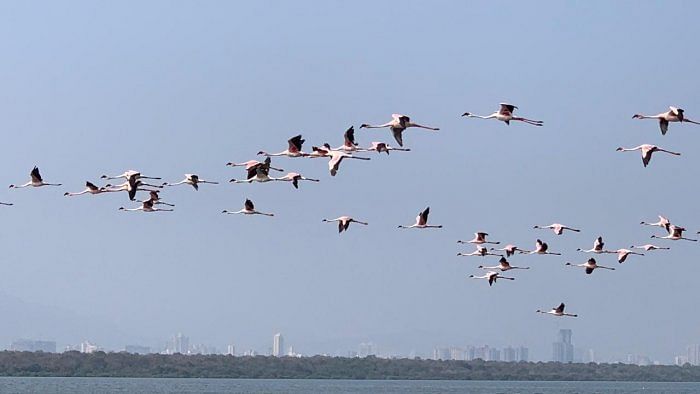
In a significant study in the Mumbai Metropolitan Region (MMR), the Mangrove Foundation has signed a MoU with the Bombay Natural History Society (BNHS India) to understand the movement pattern and habitat use by birds wintering in the Thane Creek through telemetry studies.
The study would be carried out as part of the mitigation plan with respect to the Bullet Train project.
The total budget for the project is Rs 5.29 crore.
In view of the The Mumbai-Ahmedabad High-Speed Rail (MAHSR) or the Bullet Train project, the Ministry of Environment, Forest and Climate Change (MoEF&CC) had directed for the preparation of a mitigation plan for the Thane Creek Flamingo Sanctuary (TCFS).
In this regard, the Mangrove Cell had prepared a mitigation plan which was approved by the Principal Chief Conservator of Forest (Wildlife) and Chief Wildlife Warden in May 2021.
The funds to implement the activities under the mitigation plan have been provided to the Mangrove Foundation by the National High Speed Rail Corporation Ltd. (NHSRCL).
Among the various activities planned under the mitigation plan, Rs 5.29 crore is allocated to this large scale satellite/radio tagging study of migratory birds in TCFS as proposed by BNHS.
It may be mentioned, the route will pass through a tunnel under the Thane creek bed (30 mt deep) and the NHSRCL had appointed CSIR-Central Institute of Mining and Fuel Research (CIMFR) to carry out a study in this regard and the said study showed that tunnelling can be carried out without any disturbance to the mudflats in the creek at a depth of 20-25 metres.
Intertidal mudflats in the Thane Creek provide essential feeding grounds for thousands of migratory birds.
This habitat is a productive system that supports important species with valuable ecosystem functions and provides food resources for bird assemblages. Nearly a quarter of a million birds migrate every winter to TCFS and spend nearly five to six months.
With the support of Mangrove Foundation, BNHS has been carrying out a long-term bird ringing programme in TCFS. While the ringing programme gives an idea about point-to-point movement of migratory water birds, it doesn’t reveal much about the fine scale movement and habitat use pattern in TCFS during their wintering period.
In a region like Mumbai where developmental projects are imperative, it is important to have a clear understanding of the intensity of use of Thane Creek and its adjoining areas through advanced scientific techniques so that appropriate conservation action can be taken while dealing with development projects.
“The present study is the first large-scale satellite tagging study of migratory birds anywhere in India where we are planning to satellite tag 200 birds. This study will certainly bring out some important data about the local and long distance movement of various migratory birds wintering in the Thane Creek and surrounding areas," said Virendra Tiwari, Additional Principal Chief Conservator of Forests, Mangrove Cell.
“This project will significantly enhance our understanding of the use of area by migratory waterbirds thereby, helping us to plan linear infrastructure projects without compromising the conservation significance of the region.Telemetry generates useful data to determine migratory routes, critical stopover sites, and anthropogenic barriers to migration,” said Dr Bivash Pandav, Director, BNHS.